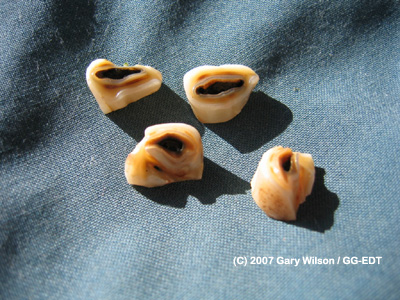Case: Unknown - Bay gelding
This case was one of the more major cases Gary witnessed on training. The bay gelding had been acquired by it's owner, who despite feeding all the right feeds, could not get the horse to gain weight. Peter had previously tried to examine the horse, which proved too fractuous to get the speculum on, but Peter had seen the severe parrot mouth the horse had, which had led to excessive growth of the upper incisors.
The plan was to reduce the incisors using a rotary cutter, examine what the state of the rest of the teeth were and take things from there. This was the only case we had witnessed a power tool being used for, and the tool used was a specially designed tool with foot controls and variable speed motor. As can be seen in the photos, water cooling was always used when the tool was in use.
First, Peter calculated how much tooth to remove in order to correct the bite, the line marking where to cut was made along the teeth in permanent marker, and the tool was used to cut nearly all the way through the teeth, but not completely. The cut sections were then removed with the incisor forceps.
Following cutting, the molars were examined and found not to be too bad, except some extreme first molars, and so were filed. Finally the incisors were finished off using the canine file to remove sharp edges to complete the job

Our patient, before sedation

Sedation is administered

Extent of the parrotmouth

If you look carefully, you can see the marker line on the teeth

Cutting begins, water flows

Cutting continues

Cutting continues - this job is not to be rushed!

Once the incisors were finished, the molars can be examined

Revealing extreme points on the rostral 6's

The points, and other molars are filed

These are the removed sections of incisor

Removing sharp edges with the canine file, revealing a very neat job!

Showing the extent of the correction
© 2007-2023 Gary Wilson / GG-EDT All rights reserved. GG-EDT, the "horse heart" device and associated names and logos are TM Gary Wilson.
